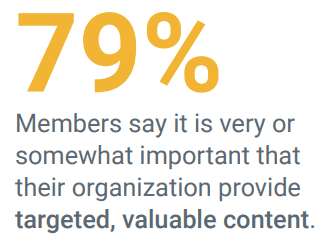A good content creation strategy can help you improve member acquisition and engagement as well as boost search engine optimization. Here are five tips to help with your association’s content creation.
A good piece of content can spark a lot of engagement. Is your association writing relevant content to market to current and prospective members and employers? If not, now is a great time to start. Once you have a content creation strategy, you’ll reap the benefits of engaging current members, driving more traffic to your website, attracting new members, and increasing your SEO.
Benefits of a good content creation strategy for associations
A good content creation strategy will help you to engage current members, drive more traffic to your website, attract new members, and increase your search engine optimization (SEO).
Other benefits of good association content include:
- Enhance relationships with sponsors and other industry leaders
- Increased traffic and search engine ranking on your association’s website
- Boost your member engagement and acquisition
- Reinforcement of your association as an industry leader
- Greater rapport with your community
5 content creation tips to engage members and improve SEO
So, how do you create great content for your association? Let’s look at five content creation tips that will engage your association’s current and prospective members while improving organic search engine ratings to help you reach a wider audience.
1. Repurpose old content for blog posts.
Your association has probably already spent a lot of time creating e-books, whitepapers, email messaging, webinars, social posts, and more. Use those content pieces as a jumping off point for creating new content. For example:
- Create a useful paper that summarizes key ideas from a popular webinar.
- Focus on a section of a great paper as a topic for an informative blog post.
- Pull together ideas from several related blog articles into a helpful guide.
Be sure not to simply copy and paste old content. Rather, present it in a new way that provides value to your members. That can be something as simple as updating data and trends from an e-book or webinar and presenting the information in a blog article. This can be an effective way to give your content an extended life and stay relevant and valuable to your members who might not have seen the original content in the first place.
2. Understand your members’ interests.
The more relevant your content is to your members’ interests, the more reach it will have. Association trends research from Momentive Software shows that job opportunities and career advancement are among the top benefits for associations. They’re especially important to those early in their careers and those who are mid-career.

This data suggests that creating content about your online career center and the benefits it offers, as well as providing helpful content to members through your career center are great ways to spark the interests of job seekers and even passive candidates. For example, you can provide career tips through articles in your career center. Also, you can promote other career-related activities that your association offers. For example, if you have a career event coming up, then blog about it to let your members and others in your industry know about it.

3. Collaborate with thought leaders in your industry.
Readers engage more with content that is interesting, relevant, and diverse. One way to create such content is by inviting leaders in your industry to contribute content by doing things like writing a guest article for your blog, providing relevant quotes for your content, or being a guest presenter on a webinar. When you collaborate with leaders of organizations that share similar audiences, you can draw new readers from their networks.
You can take it a step further and ask for quotes or stories from your members. They have knowledge of your industry and are the best ones to know what topics are relevant and important to other members and prospective members.
4. Write what you know.
Having the time and expertise to create enough content might seem challenging for your association. But it doesn’t need to be. Along with repurposing content you already have, write about what you know or reuse content that you are utilizing in other areas for quick and easy blog posts.
A few content ideas include:
- Blogging about the benefits of joining your association (include member testimonies, if possible)
- Writing a paper about how to start a career in your industry (point them to your online career planning portal)
- Collecting career tips from members who have worked in your industry for several years and compile them in a blog article or tip sheet
5. Use keywords and related synonyms to improve SEO.
SEO for improved search engine results page ranking is constantly evolving. While it can seem like a moving target, mastering it leads to better digital ranking and more traffic for your website. To attract organic traffic to your site, it’s useful to demonstrate that your organization is a leader on trending issues in your industry.
Using industry-specific keywords and related synonyms in website and blog content will help to capture traffic that’s unfamiliar with your brand name but interested in the topics your organization is addressing. Over time, readers will come to rely on the topical content you deliver and view your brand as a professional resource.
Maintain a steady cadence of relevant content for readers and include “subscribe” links in all of your outward facing communications channels.
Here are some ideas for topics that you might cover in your website and social media channels to improve your ranking in organic search results:
- To attract job seekers – Highlight professional resources and access to top industry employers available through your online job boards and career fairs.
- To attract new members – Focus on benefits important to (new and experienced) professionals in search of mentorship, networking opportunities, and continuing education.
- To attract employers to your career center – Emphasize the number of niche professionals accessible and looking for employment on your job board and at your career events.



